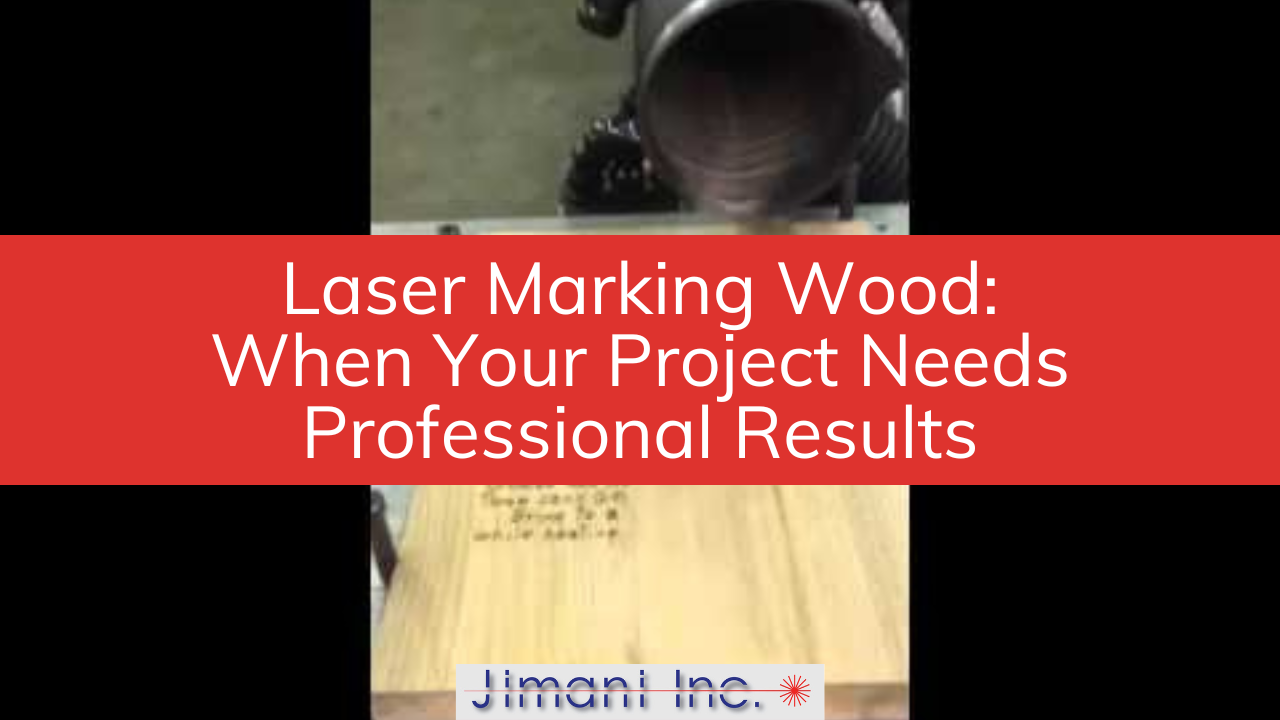Laser Marking Wood
When creating a permanent traceability mark, identifying mark, or decorative mark on wood products...
By: Jim Earman on 8/26/25 8:00 AM

A young girl came to Jimani and wanted her grandfather’s favorite recipe engraved on a piece of Myrtle wood in his handwriting. We used a 12-inch field lens due to its large field size. She wanted his spelling mistakes included, which certainly adds to the uniqueness of this piece.
Wood marking might seem straightforward until you're standing in front of a CO2 laser, trying to figure out why your maple samples look burned while your oak pieces barely show a mark. Different wood species absorb laser energy at different rates, and what works for pine can destroy cherry veneer in seconds.
That's where experience matters. At Jimani, we've been marking wood products since 1990, long enough to know that alder needs different settings than birch, and that Baltic birch plywood requires a completely different approach than solid hardwood. Our CO2 laser systems, built around US-made lasers, deliver the precision needed for everything from architectural panels to custom awards.
Wood responds to CO2 lasers because its organic structure absorbs the 10,600 nm wavelength efficiently. The laser vaporizes the wood fibers, creating contrast through controlled burning. But here's what most people discover too late: moisture content changes everything.
A piece of kiln-dried oak marks differently from the same wood with 12% moisture content. Factor in grain direction, density variations, and natural oils, and you understand why consistent results require more than just pressing start.
Our laser marking job shop handles wood marking projects that range from single custom pieces to production runs of thousands. Recent projects include serial numbering bamboo cutting boards for a kitchenware company, creating detailed logos on walnut presentation boxes, and marking QR codes on furniture components for inventory tracking. Each application demanded different power settings, marking speeds, and focal adjustments.
The marking field on our CO2 systems ranges from 5 inches square to 12 inches square, depending on the lens configuration.
Speed matters in production environments. A simple text engraving on pine might run at 40 inches per second, while detailed graphics on hard maple might require 15 inches per second with multiple passes. We've refined these parameters through thousands of jobs, documenting what works for each wood type and finish requirement.
Consider depth control. Some customers want subtle surface marking that preserves the wood's natural texture. Others need deep engraving for dimensional effects or paint filling. We can achieve depths from barely perceptible surface marks to 0.125 inches deep, though most applications fall between 0.010 and 0.030 inches. Deeper marks require multiple passes with adjusted focal points to maintain clean edges and consistent depth.
Wood finishing adds another variable. Pre-finished wood often produces different contrast than raw wood. Lacquered surfaces might need removal before marking, while some stains actually enhance laser contrast. We've developed techniques for marking through certain finishes without damage, saving customers the cost and time of refinishing.
Our typical turnaround runs 3-5 days for most wood marking projects. Rush service is available when you discover on Thursday that you need 200 marked wooden gifts for Saturday's corporate event. Pricing depends on marking complexity, material handling requirements, and quantity. A simple logo on 100 coasters costs far less per piece than unique serial numbers on oddly shaped wooden components that require individual fixturing.
One challenge unique to wood: every piece is different. Even boards from the same tree show variation in grain patterns, density, and moisture content. Our operators understand how to adjust on the fly, ensuring consistent appearance across an entire batch despite natural material variations.
We maintain sample libraries showing our marking capabilities on different wood species. Send us your material, and we'll create test marks at various settings so you can see exactly how your wood will look before committing to a production run. This sampling service has saved countless customers from discovering too late that their chosen wood doesn't mark as expected.
Ready to discuss your wood marking project? Send us your specifications or, better yet, ship us a sample piece. We'll show you exactly what's possible and provide a firm quote based on your actual requirements. Contact our laser marking job shop at (805) 486-1399 or visit jimani-inc.com.
When creating a permanent traceability mark, identifying mark, or decorative mark on wood products...
Industry: Consumer Goods
Material: Wood
Mark Data Type: Graphics, logo
Laser Mark Type: Engraved,...
Industry: Ad Specialty
Mark Type: Surface laser etch and material cutting